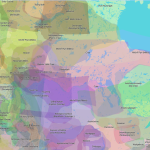Storytelling in the Classroom: More than Just Words
Stories are one of the most important ways people connect to and explain the world around them. Saskatchewan has declared February as Indigenous Storytelling Month, and National Storytelling Week will be celebrated nationwide from January 30 to February 6, 2024.
Indigenous Peoples have a strong tradition of sharing knowledge from one generation to another through storytelling. Traditional stories can communicate many different types of knowledge and practices, varying from the sacred to the historical. Many stories are filled with humour and told because they are entertaining. Others may focus on transferring social, political, and cultural knowledge. When Elders and Knowledge Keepers tell stories about the first time they went hunting or fishing, their stories include lessons and teachings. These teachings may transfer knowledge of safety practices or share the location of particularly abundant berry patches and hunting trails on their traditional lands.
One of the best ways to honour Indigenous Storytelling Month is to highlight Indigenous voices by bringing Indigenous stories into your classroom. There are a few different ways you can do this! The first is to invite an Elder or Knowledge Keeper to your classroom to share a story with your students. Ideally, spend some time with the Elder beforehand and find out what story they might want to share. This will help ensure you’re ready to support your students as they listen to the story. Having Elders share their time and knowledge is a gift, so remember to thank them appropriately using local protocol practices. If you’re not sure what the proper protocol might be, ask someone who knows!
If it’s not possible to bring an Elder into your classroom, consider looking for an online resource from an Indigenous storyteller, like a video or collection of stories. If you bring in an external resource from an Elder or storyteller you do not know personally, make sure you learn as much as you can about that individual. Which Nation are they from? What type of story are they telling? It’s important students know who the storyteller is and where they come from because each story has a specific cultural lens. Understanding this cultural lens helps students understand the story within its context. Once you share a story, you can encourage students to discuss what happened in the story and to reflect on the lessons the story might contain.
Storytelling is a powerful teaching tool because it helps students connect to, relate to, or see the world from someone else’s perspective. When students learn through storytelling, they can relate their own experiences to the story, which helps them foster a more personal connection to the content. As students hear more stories, they are more likely to draw connections between the things they hear, making topics the unfamiliar feel more familiar. The best stories are rooted in real-world context and experiences. As students hear more stories, they have more ways of understanding and connecting to the world around them. Ultimately, learning through stories helps preserve cultural identity, foster community, and strengthen students’ identities.
Try these other methods of bringing story-based learning into your classroom:
1. Share Your Own Experiences
Consider sharing your own experiences of learning and discovery. Students may be able to relate to your experiences and thought processes, helping them better understand the topic at hand.
2. Introduce New Topics Through Storytelling
Storytelling is a particularly effective way to introduce a new topic because it can act as an icebreaker. Learning through stories helps students apply knowledge and skills to real-life settings, facilitating better retention and transfer of learning. Learners may think they have no connection to a topic because they’ve never had direct experience with the material. However, stories can elicit emotional responses and give the material more context and significance. There might be a part of the story students can relate to, even if the topic you’re introducing is new.
3. Create a Character
Characters are ways to hook your students in and keep them engaged. Maybe you’re looking for ways to help learners understand the water cycle. Rather than simply describing the processes of evaporation, condensation, and rainfall, consider making water a character. Then, describe their journey from the sea and back again. This character could also talk about what happens to the water cycle when there are environmental changes or when pollutants enter the water system.
4. Organize a Storytelling Day
Stories are meant to be shared with others. Consider organizing a storytelling day with your students to help them build their oral storytelling skills. We often have students write down their stories without sharing them or reading them aloud to one another. If they get read aloud, they’re read verbatim; the written copy is considered the ideal version. However, anyone who has told an amusing anecdote multiple times knows this isn’t how orally transmitted stories work. As we tell and retell stories, it’s common to add or remove details based on our audience or to adjust phrasing or emphasis to heighten the impact. The message or core stays the same, but we dress it up differently depending on who we tell the story to.
Here are some steps to organize your own Storytelling Day:
- Encourage your students to think of something they want to tell a story about. This could be a life lesson, principle, or value they want to teach others, a difficult concept they want to explain, a historical event, or something funny they experienced. Students can brainstorm and outline their stories on paper, but encourage them to only write down the most important details.
- Introduce some features of good oral storytelling to your students, like understanding their audience, thinking about the story’s goal, and using body language.
- Have your students practice telling their stories in small groups, and encourage them to be engaged in their peers’ stories! Encourage your students to ask each other questions about the story they just heard. Learning what their fellow classmates are curious about might give the storyteller more ideas for what they want to include.
- Include a culminating event where each student shares their story with the entire class or an audience of students from a different class!
Additional Resources
Check out these resources for more ways to honour Indigenous Storytelling Month and bring storytelling into your classroom.
Library Services for Saskatchewan Aboriginal Peoples (LSSAP)
The LSSAP committee organizes in-person and online events to celebrate Indigenous Storytelling Month. Check out their website to stay up-to-date on their offerings.
National Centre for Collaboration in Indigenous Education (NCCIE)
NCCIE highlights innovative examples of Indigenous education from across the country, celebrating the dedicated work of communities to strengthen Indigenous education for all generations. They have a variety of lessons and resources you can use in your classroom.








